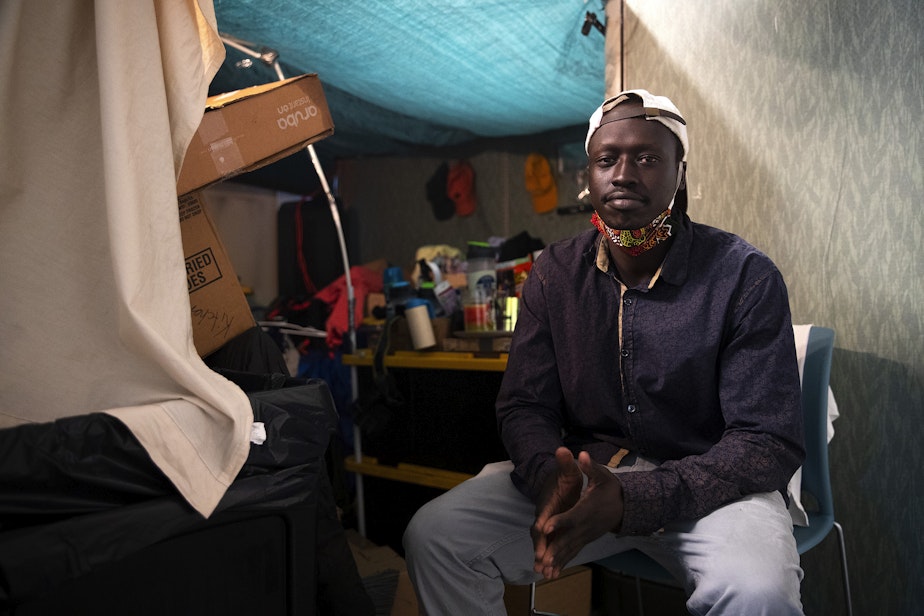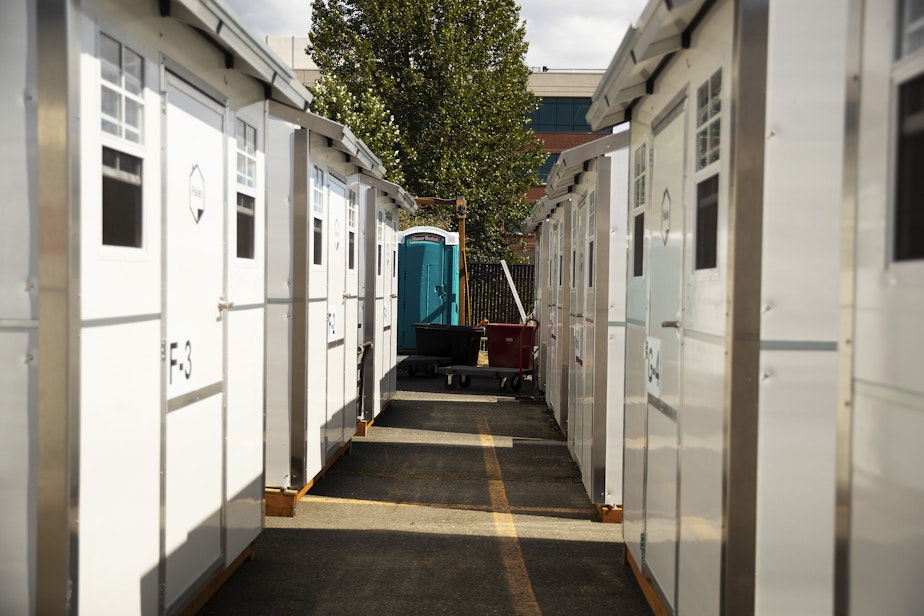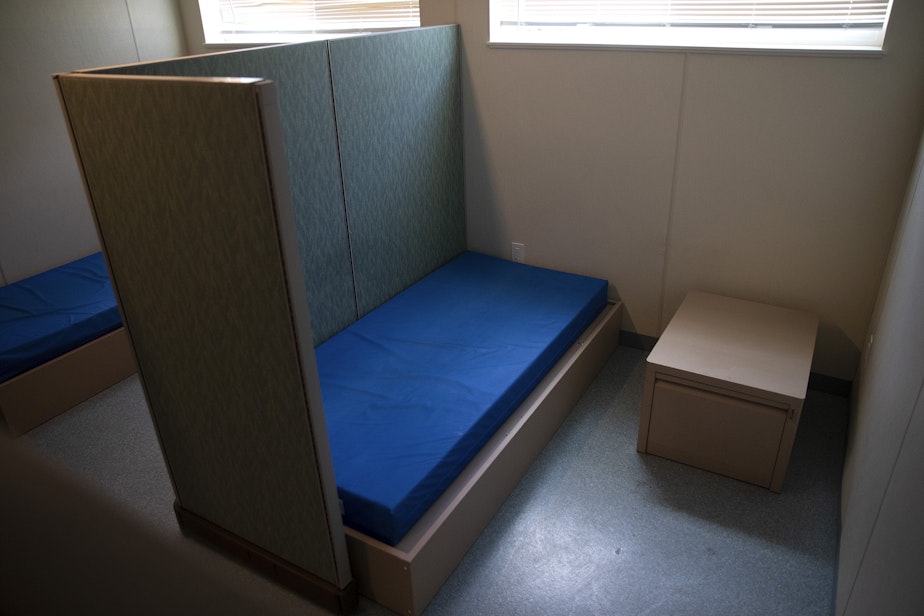The pandemic transformed Seattle's homeless shelters for the better, advocates say. But challenges remain

Pre-pandemic, accessing emergency shelter in the Seattle area often meant being packed into a room with strangers on all sides.
The pandemic spurred radical changes in the homeless shelter system, leading to more space, more privacy, and more autonomy for people.
But this shift also came with challenges, and many legacy issues remain.
The old model
Before the pandemic, on any given night, the St. Martin de Porres Shelter run by Catholic Community Services would house roughly 200 people — all men over the age of 50 who were experiencing homelessness. They slept on mats on the floor, roughly six inches apart.
This kind of congregate shelter model was common just a few years ago. It brought lots of people indoors overnight, but it didn’t offer much of a chance to stabilize. People lined up to get in during the evening, only to have to leave again the next morning.
In many places, partners, pets, and belongings couldn't be accommodated.
Sponsored
“I think that it's really hard for people to just understand the amount of energy it took for people just to survive when shelter was operating that way,” said Jennifer Newman, director of homelessness services for Catholic Community Services.
This overnight-only shelter model was exhausting for people, and not the most attractive option for many living outside.
"For the longest time ... we have promoted quantity over quality," said Noah Fay, senior director of housing programs for the Downtown Emergency Service Center, a large shelter provider in the region, in reference to the system as a whole.
Even pre-pandemic, Fay said the Downtown Emergency Service Center and some other organizations had begun the shift to shelter spaces that were more attractive to people living outside, and that more adequately met people’s needs.
These spaces gave people access 24 hours a day, not just overnight, and had more services and amenities on-site.
Sponsored
Then Covid-19 hit. And that shift that had slowly begun in the preceding years, including the siting of things like tiny house villages in the city, went into overdrive out of necessity.
"Everything about shelter changed during the pandemic," said Dan Wise, system director for Catholic Community Services.
The newer model
From the pandemic's early days, Wise said it was clear that it was going to be almost impossible to keep clients safe in the old, congregate shelters with the virus circulating. So, like others across the region and the country, shelter providers in the Seattle area were compelled to pivot.
Clients were moved into hotel and motel rooms — spaces that gave them more privacy, more ability to social distance and shelter in place like their housed neighbors, and more consistent contact with case managers and health care workers.
Sponsored
Catholic Community Services also opened a site called the Bridge Shelter in Seattle.

It was already built and waiting for clients, but it had been sitting vacant due to neighborhood opposition, according to Catholic Community Services staff.
With a public health emergency knocking at the door, the organization used the Bridge site to shelter their clients from St. Martin de Porres more safely.
There’s a dog run to accommodate people with pets, and couples are welcome. There are case management offices, laundry rooms, food, bathrooms, hygiene supplies, and services for people with complex needs like substance use disorder.
Sponsored
On one side of the lot are small stand-alone units that look somewhat like fancy garden sheds. These tiny-home-style spaces have power, air conditioning, and heating, and provide occupants with their own space.
On the other side of the lot there are spots that offer a sort of middle ground: Dorms house a handful of people in the same room, with more space and privacy than the old shelters afforded. Office cubicle-like dividers draw boundaries around each person's spot, their mattress is raised off the ground, and there's a footlocker for belongings.

For Khames, a resident of one of the dorms, it's been a positive experience.
"I mean, you tend to hear your roommate snore. But overall, it's better,” he said.
Sponsored
Khames, who requested that KUOW only identify him by his first name, had been living in his car for about a year and a half before getting a spot at the Bridge shelter just a few months ago.
In his car, he said it was hard to get good sleep. His back would hurt; it was hard to find a place to shower.
Despite that, he said if it had been the old style of shelter offered — the mat on the floor — he wouldn't have moved.
"I would have stayed in my car, honestly,” he said. “Sleeping on the mat is not so good."
At this site, Khames said it’s been a relief to have somewhere to sleep peacefully and to be able to access services to help with housing, and other needs.
He’s optimistic that he’ll be in a good place in his life by this time next year.
“I'm not gonna say it's my year, but I'm trying to make it,” he said.
The dorms, like the one where Khames is staying, can also accommodate chosen families, communities that have formed in encampments, and people with a variety of needs.
“We use this to move folks in who want to stay together, or folks that are, say, at high risk of drug overdoses so they want to, you know, have more folks checking in on them,” Wise said.
The impact
This sort of system transformation is something advocates and researchers had been calling for, for years, and it’s been well-received by the people moving into the new accommodations.
Just a couple of weeks into the pandemic, Newman, from Catholic Community Services, recalls getting a call from a client, a man in his 70s who used an oxygen tank.
“He called me from his hotel room and said, ‘Please don't ever let them make us go back to how it was,’” Newman said.
She added that the new environment helped the man become medically stable and engage fully in services. He also moved into housing during the pandemic, she said.
Newman and her colleagues noted that enabling clients to decompress and spend time out of survival mode is beneficial to their longer term stability, and is responsive to their asks.
“Now it's, 'We're giving you a locked door, we're giving you somewhere to put your stuff down and breathe and get attached to systems of care,” said Renata Bryant, a program director with Catholic Community Services.
Catholic Community Services staff say more clients are making progress, having success, and getting housed now than they were previously.
The organization has since converted all of their shelters to 24-hour spaces where people can consistently access services; they’re not alone.
At the Downtown Emergency Service Center, a similar shift has taken place in recent years, and staff say they’re seeing the same positive reception.
“We’ve seen just a huge amount of personal stability,” said Dan Williams, a housing director at the center. “Because people had their own spaces, they could really think about things that the congregate settings didn’t allow.”
Williams said clients have been better able to deal with long-term traumas and have more meaningful connections with staff.
And, anecdotally, staff say it seems fewer people are leaving to go back to the street.
“People would leave the old congregate settings on a nightly basis, because it was a really hard place to be,” said Fay, the center's director of housing programs. “And they weren't often leaving because they had a better alternative to go to, or they'd found a resolution to their homelessness — they just needed an escape from a really stressful, intense location.”
That old, revolving door meant more people could cycle through shelters, but it didn’t necessarily help to solve the issues people were facing.
The tradeoffs
Still, the new model comes with challenges, too.
Some of the hotel and motel spaces opened during the pandemic have since closed; some of those still functioning face an upcoming funding cliff. And some communities oppose this model of shelter being sited in their neighborhoods.
The ability to address the need on the street also remains a tall order.
"I would never shift back to the quantity over quality model,” Fay said. “There is just — I want to acknowledge, there's a real trade off."
The Downtown Emergency Service Center's shelters were full every night pre-pandemic, and they’re full every night now, according to Fay.
The difference lies in the throughput, the organization’s capacity to take new people into their shelters.
Fay said that has slowed down considerably. Where they may have had between five and 35 beds they could fill each night in the old congregate settings, they now have closer to one to three beds available per week in their 24-hour spaces.
Essentially, better quality can bring less quantity, for a range of reasons - like space, staffing, funding, and ability to site new shelters.
Pair that with the ongoing and significant mismatch between supply and demand and it can make things harder for people to get inside.
Over the past few years, the Downtown Emergency Service Center's transition to more enhanced shelters resulted in a loss of roughly 150 beds in that organization. Similarly, Catholic Community Services saw decreases in their capacity to shelter seniors.
On top of this, the process to get into the available shelter spaces also seems to be more involved.
“A lot of it now is through referrals. There’s a lot of bureaucracy now,” said Williams.
The idea is to ensure that the limited capacity that exists is targeted to the most vulnerable people first. It’s a delicate balancing act and the process has pain points.
Williams said the very people providers are trying to prioritize can find it hard to navigate this system.
“The lower functioning a person is, the more unlikely they are to be able to kind of jump through bureaucratic hoops,” he added.
Williams said culturally appropriate outreach, engagement, and interventions also need to be baked into the way the system functions, as opposed to being an addition or an afterthought, for truly equitable services to exist.
People are still waiting
For those still living outside, the change in the shelter system means better spaces.
But many have to wait to get in, and the process can feel lengthy, complicated, and frustrating.
“I’m still learning the system,” said Ely, who's currently living outside and spends his days in an area north of the city. Ely asked that KUOW only identify him by first name.
“I still don’t really understand the process,” he said.
Ely said he hasn’t been living outside for very long, and when he was housed, his perception of how easy it is for people experiencing homelessness to get housing and employment was different.
“You wake up in the morning and you need to go to the bathroom, or you need to go take a shower, and you don't have access to that,” Ely said. “So if you can’t do that, you can't do the next step, which is go look for a job,” he said.
The needs of each person experiencing homelessness differ. For Ely, he said he needs more than a space to sleep overnight. He needs help with employment, transportation, housing, and finding the right path.
What he’s looking for is available in the newer kinds of shelter, but that doesn’t make gaining access easier. And while he waits, Ely said being moved periodically by the city only makes it harder.
“It seems like it’s a very tangled, tangled system right now,” he said.
Even for service providers, navigating the system is complex.
For Kirby Rodriguez, an outreach coordinator with the homelessness services provider REACH, it’s tough to meet people in encampments who are ready to go to shelter when the resources simply aren’t available immediately.
"So when I do meet someone, it's more doing the pre-emptive work for shelters now like, ‘Do you have your ID? Great. OK, do you have a phone so that I can come find you?’ And playing the waiting game,” they said.
Rodriguez said getting people into shelter seems to be taking longer than it used to. It’s also complicated to match the right person with the right spot when spaces are available. Is it in their neighborhood, near their community? Do the providers speak their language? Are the right services available for them on-site?
Joel Killough is an outreach manager at REACH. He said the ongoing mismatch in supply and demand makes things challenging.
“We're stuck with saying, ‘Sorry, we can't help you today. Maybe we can try to help you next week if the thing you need will line up. Or we can make a non-ideal referral to a place that doesn't have the staff or the skill set that matches your need.’ All of those are bad options,” he said.
The transformation that has taken place for many shelter spaces in the Seattle area means that those who get in have a better chance at stability and a better chance at success.
But long-standing issues persist, and thousands of people remain outside.

